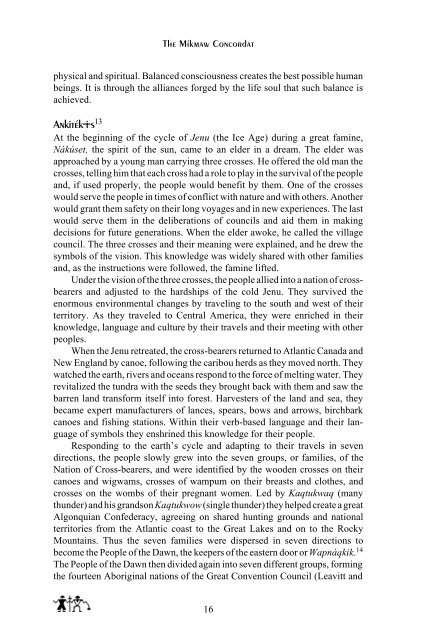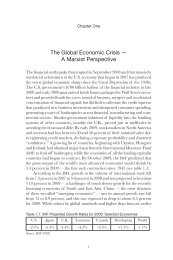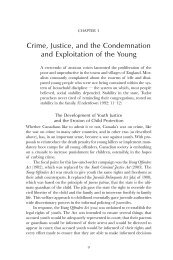Download PDF - Fernwood Publishing
Download PDF - Fernwood Publishing
Download PDF - Fernwood Publishing
You also want an ePaper? Increase the reach of your titles
YUMPU automatically turns print PDFs into web optimized ePapers that Google loves.
The Míkmaw Concordat<br />
physical and spiritual. Balanced consciousness creates the best possible human<br />
beings. It is through the alliances forged by the life soul that such balance is<br />
achieved.<br />
Ankiték i s 13<br />
At the beginning of the cycle of Jenu (the Ice Age) during a great famine,<br />
Nákúset, the spirit of the sun, came to an elder in a dream. The elder was<br />
approached by a young man carrying three crosses. He offered the old man the<br />
crosses, telling him that each cross had a role to play in the survival of the people<br />
and, if used properly, the people would benefit by them. One of the crosses<br />
would serve the people in times of conflict with nature and with others. Another<br />
would grant them safety on their long voyages and in new experiences. The last<br />
would serve them in the deliberations of councils and aid them in making<br />
decisions for future generations. When the elder awoke, he called the village<br />
council. The three crosses and their meaning were explained, and he drew the<br />
symbols of the vision. This knowledge was widely shared with other families<br />
and, as the instructions were followed, the famine lifted.<br />
Under the vision of the three crosses, the people allied into a nation of crossbearers<br />
and adjusted to the hardships of the cold Jenu. They survived the<br />
enormous environmental changes by traveling to the south and west of their<br />
territory. As they traveled to Central America, they were enriched in their<br />
knowledge, language and culture by their travels and their meeting with other<br />
peoples.<br />
When the Jenu retreated, the cross-bearers returned to Atlantic Canada and<br />
New England by canoe, following the caribou herds as they moved north. They<br />
watched the earth, rivers and oceans respond to the force of melting water. They<br />
revitalized the tundra with the seeds they brought back with them and saw the<br />
barren land transform itself into forest. Harvesters of the land and sea, they<br />
became expert manufacturers of lances, spears, bows and arrows, birchbark<br />
canoes and fishing stations. Within their verb-based language and their language<br />
of symbols they enshrined this knowledge for their people.<br />
Responding to the earth’s cycle and adapting to their travels in seven<br />
directions, the people slowly grew into the seven groups, or families, of the<br />
Nation of Cross-bearers, and were identified by the wooden crosses on their<br />
canoes and wigwams, crosses of wampum on their breasts and clothes, and<br />
crosses on the wombs of their pregnant women. Led by Kaqtukwaq (many<br />
thunder) and his grandson Kaqtukwow (single thunder) they helped create a great<br />
Algonquian Confederacy, agreeing on shared hunting grounds and national<br />
territories from the Atlantic coast to the Great Lakes and on to the Rocky<br />
Mountains. Thus the seven families were dispersed in seven directions to<br />
become the People of the Dawn, the keepers of the eastern door or Wapnáqkik. 14<br />
The People of the Dawn then divided again into seven different groups, forming<br />
the fourteen Aboriginal nations of the Great Convention Council (Leavitt and<br />
16





